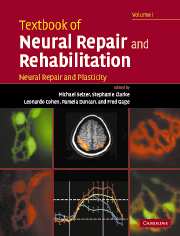Book contents
- Frontmatter
- Contents
- Contents (contents of Volume II)
- Preface
- Contributors (contributors of Volume I)
- Contributors (contributors of Volume II)
- Neural repair and rehabilitation: an introduction
- Section A Neural plasticity
- Section A1 Cellular and molecular mechanisms of neural plasticity
- Section A2 Functional plasticity in CNS system
- Section A3 Plasticity after injury to the CNS
- Section B1 Neural repair
- Section B2 Determinants of regeneration in the injured nervous system
- 21 Inhibitors of axonal regeneration
- 22 Effects of the glial scar and extracellular matrix molecules on axon regeneration
- 23 Trophic factors and their influence on regeneration
- 24 Intraneuronal determinants of regeneration
- Section B3 Promotion of regeneration in the injured nervous system
- Section B4 Translational research: application to human neural injury
- Index
22 - Effects of the glial scar and extracellular matrix molecules on axon regeneration
from Section B2 - Determinants of regeneration in the injured nervous system
Published online by Cambridge University Press: 05 March 2012
- Frontmatter
- Contents
- Contents (contents of Volume II)
- Preface
- Contributors (contributors of Volume I)
- Contributors (contributors of Volume II)
- Neural repair and rehabilitation: an introduction
- Section A Neural plasticity
- Section A1 Cellular and molecular mechanisms of neural plasticity
- Section A2 Functional plasticity in CNS system
- Section A3 Plasticity after injury to the CNS
- Section B1 Neural repair
- Section B2 Determinants of regeneration in the injured nervous system
- 21 Inhibitors of axonal regeneration
- 22 Effects of the glial scar and extracellular matrix molecules on axon regeneration
- 23 Trophic factors and their influence on regeneration
- 24 Intraneuronal determinants of regeneration
- Section B3 Promotion of regeneration in the injured nervous system
- Section B4 Translational research: application to human neural injury
- Index
Summary
Following injury to the adult central nervous system (CNS), injured axons are unable to regenerate past the lesion. Within the site of injury, referred to as the glial scar, reactive astrocytes produce chondroitin and keratan sulfate proteoglycans (CSPG/KSPG). These molecules are among the major inhibitory extracellular matrix (ECM) molecules believed to play a role in regeneration failure. The environment of the glial scar will be discussed in this chapter, with particular focus placed on the role of CSPGs in regeneration failure. The balance between CSPGs and growth promoting molecules produced by reactive astrocytes in the glial scar will be considered, as well as the behavior of regenerating neurons in the environment of CNS injury.
Introduction
The glial scar
With the exception of a small pathway in the hypothalamus (Chauvet et al., 1998) and the olfactory sensory projections within the olfactory bulb (Monti Graziadei et al., 1980; Morrison and Costanzo, 1995), severed axons within long myelinated tracks of the central nervous system (CNS) are capable only of abortive sprouting that provides little functional recovery (Ramón y Cajal, 1928; Li and Raisman, 1995). One of the major barriers to regeneration is the glial scar, in addition to myelin inhibitors (see Volume I, Chapter 21).
Keywords
- Type
- Chapter
- Information
- Textbook of Neural Repair and Rehabilitation , pp. 390 - 404Publisher: Cambridge University PressPrint publication year: 2006

